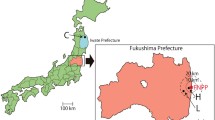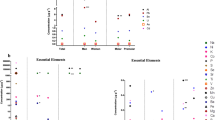Abstract
The occurrence of trace elements in the teeth of Steller sea lions (Eumetopias jubatus) collected from the North Pacific from 1968 to 1999 is described. Using particle-induced X-ray emission analysis, we detected eight trace elements: Ca, Mn, Fe, Cu, Zn, Br, Sr and Pb. We used a general linear model to evaluate long-term trends of trace element accumulation. Zn (Zn/Ca) and Fe (Fe/Ca) levels both varied during the last three decades, and showed significant differences between animals of different age (Fe/Ca), season (Zn/Ca and Fe/Ca), and sex (Zn/Ca); both Zn/Ca and Fe/Ca ratios were higher in young males than older males. Pb was detected in 39% of the samples from Hokkaido (Japan) and 22% of those from Alaska. The high levels of Pb recorded in 1975 were thought to be related to the use of leaded gasoline during the 1970s. Our results indicate that the levels of trace elements in the teeth of Steller sea lions can be used as indicators of temporal and spatial variations of trace element pollution.




Similar content being viewed by others
References
Alaska Sea Grant (1993) Is it food? Addressing marine mammal and sea bird declines. Workshop summary. Alaska Sea Grant report 93–01. University of Alaska, Fairbanks, Alaska
Arai N, Mitani Y, Sakamoto W, Yoshida K, Mokuno Y, Baba N (1999) PIXE analysis of trace elements in northern fur seal teeth. Nucl Instrum Methods Phys Res B 150:267–271
Braham HW (1973) Lead in the California sea lion (Zalophus californianus). Environ Pollut 5:253–258
Chow TJ, Earl JL (1970) Lead aerosols in the atmosphere: increasing concentrations. Science 169:577–580
Clayton E (1986) PIXAN: the Lucas Heights PIXE analysis computer package, AAEC/M133
Cruwys E, Robinson K, Davis R (1994) Microprobe analysis of trace metals in seal teeth from Svalbard, Greenland, and South Georgia. Polar Rec 30:49–52
Cruwys E, Robinson K, Boyd IL (1997) Mesurements of calcium and phosphorus concentrations in the neonatal dentine on Weddell and Crabeater seals using energy-dispersive X-ray analysis. Polar Rec 33:20–28
Dietz R, Riget F, Johansen P (1996) Lead, cadmium, mercury and selenium in Greenland marine animals. Sci Total Environ 186:67–93
Edmonds JM, Shibata Y, Prince RIT, Preen AR, Morita M (1997) Elemental composition of a tusk of a dugong, Dugong dugon, from Exmouth, Western Australia. Mar Biol 129:203–214
Ferrero RC, Demaster DP, Hill PS, Muto MM, Lopez AL (2000) Alaska marine mammal stock assessments 2000. NOAA Tech Memo NMFS–AFSC 119:60
Hamanaka T, Ito T, Mishima S (1982) Age-related change and distribution of cadmium and zinic concentrations in the Steller sea lion (Eumetopias jubata). Mar Pollut Bull 13:57–61
Hare SR, Mantua NJ (2000) Empirical evidence for North Pacific regime shifts in 1977 and 1989. Prog Oceanogr 47:103–145
Heppleston PB, French MC (1973) Mercury and other metals in British seals. Nature 243:302–304
Hirons AC, Schell DM, Finney BP (2001) Temporal records of δ13C and δ15N in North Pacific pinnipeds: inferences regarding environmental change and diet. Oecologia 129:591–601
Hoelzel AR (2002) Marine mammal biology: an evolutionary approach. Blackwell, Oxford
Honda K, Fujise Y, Itano K, Tatsukawa R (1984) Composition of chemical components in bone of Striped dolphin, Stenella coeruleoalba: distribution characteristics of heavy metals in various bones. Agric Biol Chem 48:677–683
Honda K, Fujise Y, Tatsukawa R (1986) Age-related accumulation of heavy metals in bone of the striped dolphin, Stenella coeruleoalba. Mar Environ Res 19:1–18
Horning M, Trillmich F (1997) Development of hemoglobin, hematocrit, and erythrocyte values in Galapagos fur seals. Mar Mammal Sci 13:100–113
Kooyman GL (1989) Diverse divers. Springer, Berlin Heidelberg New York
Lee LTH, Takahashi S, Saeki K, Tanabe S, Miyazaki N, Fujise Y (1999) High percentage of butyltin residues in total tin in the livers of cetaceans from Japanese coastal waters. Environ Sci Technol 33:1781–1786
Lippard SJ, Berg JM (1994) Principles of bioinorganic chemistry. University Science Books, Mill Valley
Loughlin TR, Perlov AS, Vladimirov VA (1992) Range-wide survey and estimation of total number of Steller sea lions in 1989. Mar Mammal Sci 8:220–239
Merrick RL, Calkins DG (1996) Importance of juvenile walleye pollock, Teragra chalcogrammma, in the diet of Gulf of Alaska Steller sea lions, Eumetopias jubatus. NOAA Tech Rep NMFS 126:153–166
Merrick RL, Loughlin TR (1997) Foraging behavior of adult female and young-of-the-year Steller sea lions in Alaskan waters. Can J Zool 75:776–786
Merrick RL, Loughlin TR, Calkins DG (1987) Decline in abundance of the northern sea lion, Eumetopias jubatus, in Alaska, 1956–86. Fish B 85:351–365
Merrick RL, Chumbley MK, Byrd GV (1997) Diet diversity of Steller sea lions (Eumetopias jubatus) and their population decline in Alaska: a potential relationship. Can J Fish Aquat Sci 54:1342–1348
Miles AK, Hills S (1994) Metals in diet of Bering Sea walrus: Mya sp as a possible transmitter of elevated cadmium and other metals. Mar Pollut Bull 28:456–458
Mitani Y, Arai N, Sakamoto W (1997) PIXE analysis of trace elements in cetacean teeth. Int J PIXE 7:135–139
Outridge PM, Stewart REA (1999) Stock discrimination of Atlantic walrus (Odobenus rosmarus rosmarus) in the eastern Canadian Arctic using lead isotope and element signatures in teeth. Can J Fish Aquat Sci 56:105–112
Outridge PM, Evans RD, Wagemman R, Stewart REA (1997) Historical trends of heavy metals and stable lead isotopes in beluga (Delphinapterus leucas) and walrus (Odobenus rosmarus rosmarus) in the Canadian Arctic. Sci Total Environ 203:209–219
Radchenko VI (2001) Results of ecosystem studies of biological resources in the far-eastern seas in 1990s. PICES Press 9:20–24
Riedman M (1990) The pinnipeds, seals, sea lions, and walruses. University of California Press, Berkeley, Calif.
Saeki K, Nakajima M, Noda K, Loughlin TR, Baba N, Kiyota M, Tatsukawa R, Calkins DG (1999) Vanadium accumulation in pinnipeds. Arch Environ Contam Toxicol 36:81–86
Saeki K, Nakajima M, Loughlin TR, Calkins DG, Baba N, Kiyota M, Tatsukawa R (2001) Accumulation of silver in the liver of three species of pinnipeds. Environ Pollut 112:19–25
Shen GT, Boyle EA (1987) Lead in corals: reconstruction of historical industrial fluxes to the surface ocean. Earth Planet Sci Lett 82:289–304
Springer AM (1992) A review: Walleye pollock in the North Pacific—how much difference do they really make? Fish Oceanogr 1:80–96
Tanaka S (2001) Trace elements in canine teeth of northern fur seals as indicators of life history (in Japanease). MSc thesis. Kyoto University, Kyoto
Thomas VM, Socolow RH, Fanelli JJ, Spiro TG (1999) Effects of reducing lead in gasoline: an analysis of the international experience. Environ Sci Technol 33:3942–3947
Trites AW, Larkin PA (1996) Changes in the abundance of Steller sea lions (Eumetopias jubatus) in Alaska from 1956 to 1992: how many were there? Aquat Mammal 22:153–166
Trites AW, Christensen V, Pauly D (1997) Competition between fisheries and marine mammals for prey and primary production in the Pacific Ocean. J Northwest Atl Fish Sci 22:173–187
Wagemman R, Stewart REA (1994) Concentration of heavy metals and selenium in tissues and some foods of walrus (Odobenus rosmarus rosmarus) from the eastern Canadian Arctic and sub-Arctic, and associations between metals, age, and gender. Can J Fish Aquat Sci 51:426–436
Winship AJ, Trites AW, Calkins DG (2001) Growth in body size of the Steller sea lion (Eumetopias jubatus). J Mammal 82:500–519
World Health Organization (1995) Inorganic lead. Environ Health Criteria 165
Acknowledgements
We thank T. Ito (Asahi University), T. R. Loughlin (NOAA) and A. S. Perlov (TINRO) for providing samples, all those who helped with the sample collection in Hokkaido, and S. Wakasa, who gave helpful suggestions about the PIXE analysis. We also thank J. R. Bower, T. R. Loughlin, P. R. Rigby and T. Umezu for their helpful comments on the manuscript.
Author information
Authors and Affiliations
Corresponding author
Appendices
Appendix 1
Appendix 2
About this article
Cite this article
Ando, N., Isono, T. & Sakurai, Y. Trace elements in the teeth of Steller sea lions (Eumetopias jubatus) from the North Pacific. Ecol Res 20, 415–423 (2005). https://doi.org/10.1007/s11284-005-0037-x
Received:
Accepted:
Published:
Issue Date:
DOI: https://doi.org/10.1007/s11284-005-0037-x




